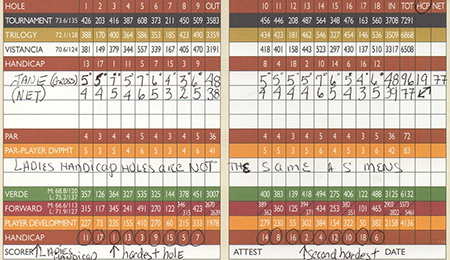You arrive at a golf competition and are handed a scorecard with a bunch of dots printed across it. Why do some of the ladies in your foursome have more dots than others, and what the heck do all those dots mean? Let's make some sense out of what can be one of the most intimidating things for a new golfer to learn: how to handicap a scorecard.
Handicapping your scorecard (sometimes referred to as stroking or dotting a scorecard) means using your Course Handicap and your Handicap Index to determine which holes you are expected to shoot over par.
Handicap Index: the measure of a player's demonstrated ability calculated against the slope rating of a golf course of standard playing difficulty.
Course Handicap: represents the number of strokes needed to play to par of the tees being played.
In order to play in a competition, you will need to have a Handicap Index. If you've had a chance to experience some challenging, longer golf courses and some that are shorter with less bunkers or water, you'll know intuitively that some courses would be rated more difficult than others. To accommodate that, your Handicap Index is a portable number you carry around with you that is converted to a Course Handicap for the tees you are playing that day, based on the difficulty of that particular course.
On a regulation size golf course, each of the 18 holes have been rated in terms of difficulty, from 1 to 18, with the most difficult hole on the course being the #1 handicap hole, and the easiest hole on the course being the #18 handicap hole (although I don't personally find any golf holes "easy".)
When I teach new golfers the basic rules and etiquette of golf, I recommend that they go to GHIN.com or download the USGA GHIN app to look up their Course Handicap before playing a new golf course.
Fine so far, right? But, how do we get to the dots? If you are playing an individual net event, let's say your Course Handicap from the tees you're playing today is a 21. You will receive 21 total dots (or strokes) on your card. Doing the math by subtracting 18 from 21 tells us you will get two strokes on the three most difficult holes, and one stroke each on the other 15 holes.
When playing in a team competition, the committee in charge of the competition will print your name, Course Handicap and your dots on the appropriate holes on your scorecard. Some competition formats should only give you a percentage of your Course Handicap, so you may see a course handicap number that is lower than the Course Handicap you saw on the GHIN app.
You may hear players say, "I can't play to my handicap!" meaning, they don't shoot their exact handicap very often, but its only expected that you play to your handicap about 20 percent of the time.
By utilizing the USGA handicap system and receiving strokes on the more difficult holes, all players are able to compete equally for a serious tournament or a fun round with your girlfriends!


